Class 78
June 5th
Warm-Up:
How many ways can you
think of to light a fire without using a small fire (e.g.
matches, lighter, magnesium sparks...) to get the big fire
started?
Today:
- Tie up loose ends
- Turn in textbooks
- Toast Marshmallows -- Physics of primitive fire making
|
Class 77
June 3rd
Warm-Up:
1. Forward I'm heavy. Backward I'm not. What am I?
2. Figure out the pattern. Then tell what
comes after 15 in the last series. 7, 5, 4
2, 3, 5, 4 12,6,3,5,4
1,3,5,4 15...
Today:
- Return Quizzes
- Check grades
- Turn in textbooks
- Wrap things up
- Exam review / study time
Handouts: See
final exam prep page
Homework:
Find your textbook and bring it to next class.
Study for the final.
|
Class 76
May 29th
Warm-Up:
How does the ring shooter work?
Today:
- Electricity Quiz
- Work on solar cookers
- Make-up time
Homework:
- Turn in missing assignments
- Bring books to class
|
Class 75 May 22th
Warm-Up:
Something strange happens when I drop a
magnet down a copper pipe. What happens, and why?
Today:
Homework:
|
Class 74 May 19th
 Warm-Up: Warm-Up:
What will happen if I run 115V of household
current through a pickle?
Why?
Today:
- Finish motors
- Complete quiz review
- Wiring activity?
Homework:
|
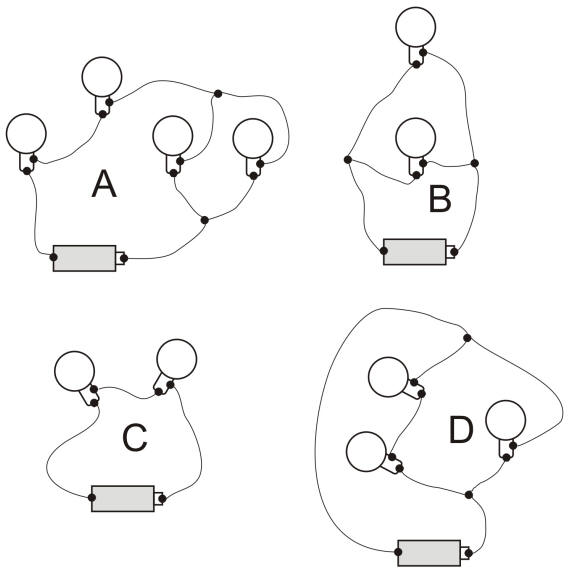 Class
73
May 15, 2014 Class
73
May 15, 2014
Warm-Up:
1. Which of the circuits on the right are
series circuits?
2. Which circuits are parallel?
3. In which direction do the electrons flow,
in the diagrams?
4. In some of these circuits, one
light bulb burning out can cause all of the light bulbs to
burn out. In which circuits could this happen?
5. How do light bulbs work?
Today:
- A1/2, A5/6: finish discussing phet simulation;
make solenoid buzzers.
- A3/4: finish buzzers. Wiring circuits or
motor.
|
Class 72
May 13, 2014
Warm-Up:
What are these pictures supposed to convey?
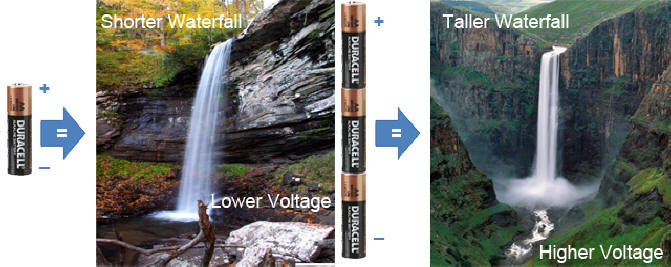
Today:
- Finish Electricity notes Part I? Electrostatics.
- Electricity notes Part II. Circuits.
- If there's time -- Make a Solenoid Buzzer.
|
Class 71
May 6, 2014
Warm-Up:
- When you plug an appliance into a typical
wall receptacle, how many volts of electric potential is the
appliance receiving.
- The Van de Graaff generator produces an
electrical potential of thousands of volts.
- Which will give you a stronger shock, the
electricity in a wall receptacle or a Van de Graaff generator?
- Why?
Today:
- Projects are graded -- many are missing. Turn in
your instrument project recordings.
- Contest Results
- Electricity notes Part I. Electrostatics.
- Electricity notes Part II. Circuits.
Current Contest Rankings: Overall rank = Doppler rank +
2*(Name That Tune Rank). Yellow teams are missing either
doppler or name that tune data.
Scaled Rank
(2xNTT + D) |
|
Current
Overall Rank |
|
5 |
Natalie, Karyn, Mackenzie |
1 |
|
16 |
Jackie, Morgan, Dominique |
2 |
|
17 |
Eniz, Zach, Peter |
3 |
|
21 |
Alex, Sam, Sarah |
4.5 |
|
21 |
Allie, Anna, Emily |
4.5 |
|
21 |
Tran, Ellie |
6 |
|
28 |
Alyssa, Sophie, Deanna |
7 |
|
29 |
Sarah, Sonja, Ashlyn |
8.5 |
|
29 |
Kara, Christina |
8.5 |
|
33 |
Emily, Danielle |
10 |
|
36 |
Charlotte, Maria, Faris |
11 |
|
37 |
Justin, Jake |
12 |
|
40 |
Alex, Ben |
14 |
|
40 |
Hannah, Gabrielle |
14 |
|
40 |
Ryan, Chris, Dom |
14 |
|
42 |
Pat and John |
16 |
|
44 |
Liam, Carolyn |
17 |
|
45 |
Adam, Belan |
18 |
|
49 |
Mary, Sarah F., Shelby |
19 |
|
51 |
Adam, Trevor |
20 |
|
54 |
Dylan, Chris G, Zach |
21 |
|
55 |
Andrew, Tyler |
22 |
|
|
|
|
Groups in yellow are missing some contest component. |
Homework: ?
|
 Class
70
May 6, 2014 Class
70
May 6, 2014
Warm-Up:
The "triboelectric series" (on the right) ranks
materials based on some property. Can you guess the property? Today:
- I haven't finished grading all of the project .wav
files. I'll have that done by next class.
- A1/2 -- contest, Electrostatics
- A3/4 -- finish name that tune. Electrostatics
- A5/6 -- finish contest. Test. Electrostatics
Current Contest Rankings: Overall rank = Doppler rank +
2*(Name That Tune Rank)
|
Doppler Velocity Determination Contest |
|
Rank |
Group |
#1 error |
#2 error |
#3 error |
Average
Error |
|
1 |
Adam, Belan |
0.25% |
0.00% |
0.00% |
0.08% |
|
2 |
Charlotte, Maria, Faris |
34.54% |
0.11% |
0.91% |
11.85% |
|
3 |
Liam, Carolyn |
0.51% |
21.29% |
18.78% |
13.53% |
|
4 |
Sarah, Sonja, Ashlyn |
0.01% |
43.60% |
0.04% |
14.55% |
|
5 |
Pat and John |
33.08% |
66.00% |
10.10% |
36.39% |
|
6 |
Alex, Sam, Sarah |
0.00% |
54.76% |
79.87% |
44.88% |
|
7 |
Alex, Ben |
33.01% |
45.14% |
59.63% |
45.93% |
|
8 |
Eniz, Zach, Peter |
138.67% |
15.20% |
10.84% |
54.91% |
|
9 |
Hannah, Gabrielle |
82.26% |
43.59% |
39.73% |
55.20% |
|
10 |
Allie, Anna, Emily |
163.23% |
31.10% |
19.59% |
71.30% |
|
11 |
Emily, Danielle |
799.75% |
22.63% |
442.24% |
421.54% |
|
Name That Tune Contest |
|
Rank |
Group |
Name That Tune Score |
|
1 |
Eniz, Zach, Peter |
21 |
|
2 |
Allie, Anna, Emily |
20 |
|
3 |
Alex, Sam, Sarah |
19 |
|
4 |
Kara, Christina |
19 |
|
5 |
Tran, Ellie |
18 |
|
6 |
Sarah, Sonja, Ashlyn |
14 |
|
7 |
Pat and John |
11 |
|
8 |
Faris, Charlotte, Maria |
10 |
|
9 |
Liam, Carolyn |
8 |
Homework: None
|
Class 69
May 4, 2014
Warm-Up:
Explain this video -- " Amazing
Water and Sound Experiment" -- One class has already
seen this. Today:
- Practice time (except A56)
- Contest
- Finish project recordings and email to Mr. Stapleton.
Try to send them all in one message.
Homework:
|
Class
68 April 30, 2014
Warm-Up:
Why does your hair stand on end when you rub a balloon on your
head?
Today:
Homework:
- Contest next class. Decide who will play and who
will guess.
|
Class
67 April 28, 2014
Warm-Up:
Get out your instrument. Listen to these changes in pitch.
Try to match the interval with your instrument. See if you
can determine the change in pitch, measured in half-steps.
1. Interval 1
2. Interval 2
3. Interval 3
4.
What about this train? (2nd file)
Today:
Homework:
- A1/2 and A 3/4: Test next class. A 5/6:
Test on Tuesday.
- Contest on Friday. Songs and Doppler ID.
(Final song list)
There will be no volume contest
this year.
- Turn in all project recordings and Doppler ID sheet. by Friday.
|
 Class
66 Thursday,
4/17/14 Class
66 Thursday,
4/17/14
Warm-Up: Practice test
questions20.
Explain how electricity causes a speaker cone to move in
and out.
 21.
Explain how a magnetic guitar pickup sends signals to an
amplifier. 21.
Explain how a magnetic guitar pickup sends signals to an
amplifier.
22.
What does an amplifier do?
23.
Why is the pickup wire coated with enamel?
24.
Why does the pickup wire need to be wound so many times?
25.
Why does the pickup wire need to be so thin?
26.
Why won’t the pickup work if the wire gets broken?
Today:
Homework:
- Practice test due on the Monday after break. Look
at the solutions if you need to.
- Name that tune contest on Friday after break. Also
doppler identification contest.
- Test on Wednesday after break.
|
Class
65 Tuesday,
4/15/14
Warm-Up:
1. What is the
real shape of the
standing wave in a plucked string?
2. When music experts talk about the pitch of a vibrating
string, they talk about "fundamental" frequency and " harmonics."
What do these terms mean?
How can you hear them on a string
instrument?
3. Why are some pickups called "humbuckers?"
4. Why should
Hz be capitalized?
(my apologies for getting it wrong
for my entire life up until now)Today:
- How to play at home...
- speakers
- playing through a PC -- control panel (sometimes
delayed)
- Begin recordings
- You may need to plug in your mic to the microphone jack
before
you open Audacity. If you want to listen as you
record, get into the control panel and make that happen.
You will need headphones. Recording directions are
in your
project guidelines.
- Get
practice test and
answers
Homework:
- Practice test due on the Monday after break.
- If you want your own plugs, scrounge for old headphone
plugs or other audio plugs.
- Bring in headphones so that you can listen to your
recordings.
|
Class
64 Friday,
4/10/14
Warm-Up:
1. What was the
loudest noise ever?
2. What's the difference between melody and harmony?
3. What's the difference between vibrato and tremolo?
Today:
- Melody vs Harmony
- Finish Music Notes
- Create a spreadsheet for marking frets (even if you
didn't use a spreadsheet)
- Turn-in your spreadsheet by emailing it to Mr.
Stapleton.
- Mark your fret marks. Mark minor and major keys if
you want.
- Start making recordings.
Handouts:
Homework:
- If you want your own plugs, scrounge for old headphone
plugs or other audio plugs.
- Bring in headphones so that you can listen to your
recordings.
|
Class
63 Wednesday,
4/9/14
Warm-Up:
Suppose you calculate the correct position of your
first fret mark, based on the correct frequency for that musical
note. When you hold the string down at that first fret
mark (one half step above the "open string") and pluck, you may
find that the pitch is not exactly what you expected.
1. What might cause the pitch to be different from the
frequency you used in your calculations? [hint: you're
pushing the string downward]
2. Will the actual frequency tend to be too high or too
low?
Today:
- Brainstorm songs for "name that tune" competition.
- Finish pickups. Try instruments. Make
recordings.
- How to listen as you record.
Handouts:
Homework:
- If you want your own plugs, scrounge for old headphone
plugs or other audio plugs.
- Bring in headphones so that you can listen to your
recordings.
|
Class
62 Monday,
4/7/14
Warm-Up:
Suppose the frequency of a musical note is 500hz...
1. What is the frequency of a note one octave
higher?
2. What is the frequency of a note two octaves higher?
3. What is the frequency of a note 1 half step higher?
4. What is the frequency of a note 2 half steps higher?
Blocks 1 (8:30) and 2 (9:30) - Check out Dale Earnhardt's show
car at CTE
Today:
- Some classes see Dale Earnhardt's show car
- Get instruments working
- Add fret marks?
- Brainstorm songs for "name that tune" competition.
Handouts:
Homework:
|
Class
61 Thursday,
4/3/14
Warm-Up:
True:
If you create an electric current in a coil of wire,
that wire will push or pull a nearby magnet.
True: If you move a magnet near
a coil of wire, you will create an electrical current in the
coil of wire.

*The diagram on the right shows some of the parts
of a speaker. The yellow wires are part of a circuit that is
powered by a stereo. The stereo provides current that
alternates in direction and magnitude.
How does this create sound?
Today:
- Finish notes --
physics and
music
- Create fret placement calculators
- Work on instruments -- begin making your pickup
when your instrument works acoustically.
Handouts:
Homework:
- Review your instrument notes.
- Think about how to amplify your instrument without an
electric amp.
|
Class
60 Tuesday,
4/1/14
Warm-Up:
None -- website wasn't workingToday:
- Return Tests
- Finish notes on music
- Create fret placement calculator
Handouts:
Homework:
- Think about how you might want to design your
instrument. Hopefully you can build it next class.
|
Class
21 Friday,
3/28/14
Warm-Up:
How do you think we might make lever sledding even
safer than before?
Today:
Handouts:
Homework:
- Think about how you might want to design your
instrument. Hopefully you can build it next class.
|
Class
59 Wednesday,
3/26/14
Warm-Up:
Some instruments are played with bows.
1.
How does a bow cause the a string to make sound?
2. What needs to be added to the bow so that it can perform at
its best
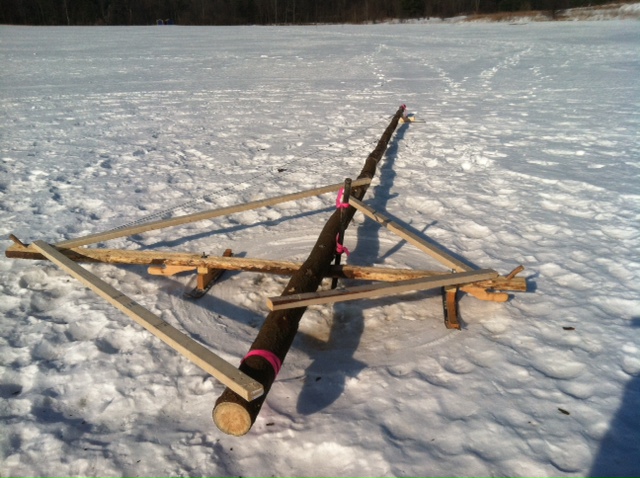
Today:
- Sledding... hopefully.
- If the sled doesn't work: waves concepts applied
to music and instrument design
Handouts:
Homework:
- Study for test. Test on Friday.
|
Class
58 Monday,
3/24/14
Warm-Up:

1. How many nodes and antinodes are in shown
in the standing wave above? How many wavelengths?
2. What is the wavelength of the standing wave?
3. If the frequency of the standing wave is
220hz, what is its velocity?
4. At that same velocity, how long should
the wavelength be in order to produce a frequency of 440hz (an "A"?
5. What characteristics determine the
frequency of a plucked string? Why?
Today:
- Discuss the test -- finish practice test discussion if
necessary.
- Introduction to electric diddley bow project, major and
minor keys, etc.
- Design/plan your instrument. Will you need to
bring materials?
- Fret placement calculations.
Handouts:
Links:
Homework:
- Study for test. Test on Friday.
- Snow lever on Monday.
|
Class
57 Thursday,
3/20/14
Warm-Up: 1. Sound volume is measured in decibels. The
table below relates sound pressures (amplitudes) to decibels. Do you notice
anything interesting? Do you have any questions?
2. How loud is the unit ventilator?
3. Why is there a limit regarding how
loud a sound can be?
|
Source of sound (in air) |
Sound Pressure -- amplitude
(psi) |
Volume in Decibels, calculated by
20*LogP/Po |
Po (threshold of hearing, in
psi) |
Loudest Pressure divided by Quietest Audible Pressure |
|
Shockwave (distorted sound waves > 1 atm;
waveform valleys are clipped at zero pressure) |
14.69543147 |
194.0956869 |
2.9E-09 |
5,067,390,163 |
|
Theoretical limit for undistorted sound at 1 atmosphere environmental pressure |
14.69543147 |
194.0956869 |
|
|
|
Stun grenades |
2.900652647 |
180.0019545 |
|
|
|
Simple open-ended thermoacoustic device[6] |
1.830166788 |
176.0018534 |
|
|
|
.30-06 rifle being fired 1 m to
shooter's side |
1.053662074 |
171.206067 |
|
|
|
M1 Garand rifle being fired at 1 m |
0.728498912 |
168.0006182 |
|
|
|
Rocket launch equipment acoustic tests |
0.580130529 |
166.0225545 |
|
|
|
Jet engine at 30 m |
0.091660624 |
149.9956962 |
|
|
|
Threshold of pain |
0.009166062 |
129.9956962 |
|
|
|
Vuvuzela horn at 1 m |
0.002900653 |
120.0019545 |
|
|
|
Hearing damage (possible) |
0.002900653 |
120.0019545 |
|
|
|
Jet engine at 100 m |
0.029006526 |
140.0019545 |
|
|
|
Non-electric chainsaw at 1 m |
0.000913706 |
109.9681656 |
|
|
|
Jack hammer at 1 m |
0.000290065 |
100.0019545 |
|
|
|
Traffic on a busy roadway at 10 m |
9.15156E-05 |
89.98194182 |
|
|
|
Hearing damage (over long-term exposure, need not be
continuous) |
5.16316E-05 |
85.01035459 |
|
|
|
Passenger car at 10 m |
2.90065E-05 |
80.00195455 |
|
|
|
EPA-identified maximum to protect against hearing loss and
other disruptive effects from noise, such as sleep
disturbance, stress, learning detriment, etc. |
|
#NUM! |
|
|
|
Handheld electric mixer |
5.51124E-06 |
65.57702656 |
Classroom Unit Ventilator |
|
|
TV (set at home level) at 1 m |
2.90065E-06 |
60.00195455 |
|
|
|
Normal conversation at 1 m |
2.90065E-06 |
60.00195455 |
|
|
|
Very calm room |
9.19507E-08 |
30.02313979 |
|
|
|
Light leaf rustling, calm breathing |
9.16606E-09 |
9.995696197 |
|
|
|
Auditory threshold at 1 kHz |
2.90065E-09 |
0.001954545 |
|
|
Today:
- Go over homework.
- Final mechanical waves info -- finish notes
and practice test
- Air Pressure
Handouts:
Homework:
- Study for test. Test next Friday.
- Barring unforseen troubles, snow lever next Wednesday.
|
Class
56 Tuesday,
3/18/14
Warm-Up:
Some fireplaces and wood stoves have blowers.
When the blower operates at the resonant
frequency of some part of the fireplace, the stove rattles or
buzzes.
As a stove heats up, it often buzzes for a while and then stops.
The buzzing may start and stop several times over the course of
a day. If the blower always operates at the same rpm, why
does the buzzing start and stop?
Today:
- Try to fling stuff or people with the snow lever -- if it
hasn't broken in a previous class
- Continue Mechanical Waves. Work on
Practice Test
Handouts:
Practice Test
Homework:
A1/2 -- Practice test, 1-23
A3/4 -- Practice Test, 1-31
A5/6 -- Practice Test 1-31
|
Class
55 Friday,
3/14/14
Warm-Up:
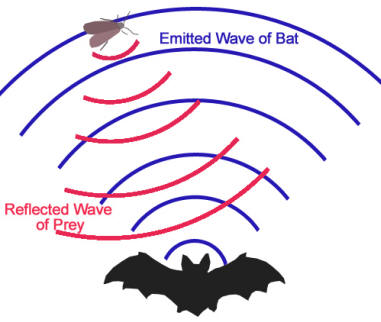 Bats
have two very sensitive ears and the ability to produce prolonged
series of sound waves. By making a sound and then listening to
the echo, how can a bat hear a difference between... Bats
have two very sensitive ears and the ability to produce prolonged
series of sound waves. By making a sound and then listening to
the echo, how can a bat hear a difference between...
1. ...an object to its left versus its
right?
2. ...distant objects versus nearby objects?
3. ...large objects versus smaller objects?
4. ...objects moving toward versus away from
the bat?
5. You see a flash of lightning. 10 seconds
later, you hear the thunder. How far away was the lightning
strike?
Today:
- Blocks A1/2 and A3/4: Check homework
- Wrap up introductory mechanical waves stuff (resonance, more problems
for homework)
Handouts:
Homework: A56 -- complete Waves practice #1
|
Class
54 Wednesday,
3/12/14
Warm-Up:
- The speed of sound in air is about 768 miles
per hour. What happens when a noisy object travels faster
than the sounds it is producing?
- Suppose you're standing next to a highway,
listening to the passing cars. What happens to the cars'
pitch as they pass by? Do you know why?
Today:
- Discuss Test questions -- force vs speed
- Waves
Videos from last year:
Homework:
Blocks A1/2 and A3/4 -- complete #1-23 on waves practice sheet.
Block A5/6 -- no homework.
|
|
Class
53 Monday,
3/10/14
Test today, in Library Computer Lab
|
|
Class
52 Thursday,
3/6/14
Today:
- Test review
- Spreadsheet problems --
Practice Test #1. Be prepared for the relative
positions of the cells to be different.
- Begin next topic: Waves
Homework:
- Test next class.
- Bring snow clothes next
Wednesday. We will try the snow lever (weather
permitting, and assuming it doesn't break during an earlier
block).
|
|
Class
51 Friday,
2/21/14
Warm-Up:
Is curling ice (for the sport of curling) rougher or
smoother than regular ice?
Today:
Homework:
- Test on the 2nd class day after break.
|
 Class
50 Wednesday,
2/19/14 Class
50 Wednesday,
2/19/14
Warm-Up:
1. An arch can't support itself if the top pieces are
missing, but a dome can. Why?
Today:
Homework:
|
 Class
49 Monday,
2/17/14 Class
49 Monday,
2/17/14
Warm-Up:
1. How does an arch (like the one on the right)
support itself?
2. The arrows in the second diagram represent forces of
different magnitudes and directions,
 acting
on an object. In which direction will the object move?
3. In the third diagram on the right, which
of the two arches is most stable? 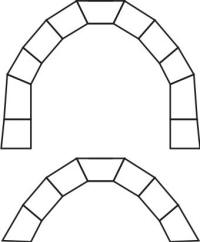
4. In a stable arch, what type of force plays the
biggest role -- compression, tension, or bending?
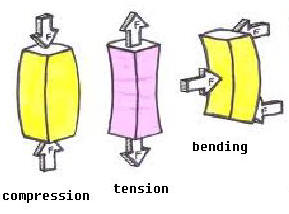

5. If you hold an egg in your palm and squeeze it, why is
it so hard to crack?
6. How did Mr. Stapleton design this stable arch?
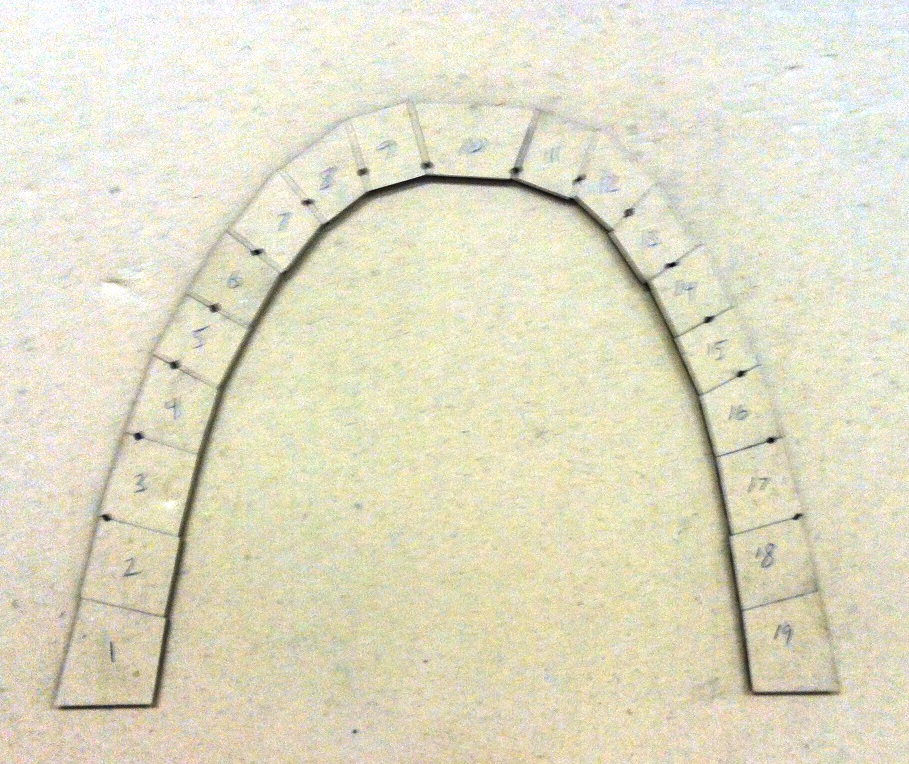 Link Link
Today:
Homework:
|
|
Class
48 Thursday,
2/13/14
Today:
- Check homework problem.
- Activity: creating and testing simple machines.
Homework:
- Bring snow clothes on Monday!
|
Class
47 Tuesday,
2/11/14
Warm-Up:
When a wooden dart was fired into the class pendulum,
the pendulum's mass was 0.722kg. The dart's mass was
0.023kg. After the collision, the pendulum swung to a
height of 0.76m. What was the dart's mass before the
collision?

Today:
- Example mechanical advantage calculation
- Calculate the mechanical advantages of ten machines.
Homework:
- Ballistic pendulum problem #2.
|
Class
46 Friday,
2/7/14
 Warm-Up: Warm-Up:
1. Have you ever tied a trucker's hitch?
2. A trucker's hitch includes a simple machine that has * a
mechanical advantage of two. Explain.
video
Today:
- Discuss homework
- Return Quizzes
- Ballistic Pendulum Calculations
- Calculate mechanical advantages
Homework: None
|
|
Class
45 Wednesday (advisory
day),
2/5/14
Today:
- Quiz: Momentum and Impulse
- Ballistic Pendulum Calculations
- Mechanical advantage activity (simple block and tackle)
Homework:
- Read textbook section 8.7. Answer review
questions 5,14, and 16, on page 117.
|
|
Class
44 Monday,
2/3/14
Today:
Homework:
- Quiz next class over impulse and momentum notes, textbook
questions, nerf dart calculations, and ballistic pendulum
calculations.
|
 Class
43 Thursday,
1/30/14 Class
43 Thursday,
1/30/14
Warm-Up:
If the mass of the ball is equal to the
mass of the pendulum, how will the velocity "just after
collision" compare to the velocity of the ball "before
collision?"
Today:
Homework:
- Finish all of the problems in the "momentum notes" handout.
- Calculate the average force that propelled your Nerf dart
during it's fastest launch.
Other:
Mythbusters season 1 episode 12 chicken gun
|
|
Class 42 Tuesday,
1/28/14
Warm-Up:
Two cars crash into one another.
1. What happens to their net
momentum during the crash?
2. What happens to their net
energy during the crash?
Today:
- Finish the notes on impulse and momentum
- Nerf dart activity. Make a Nerf dart fly as fast as
possible, powered only by compressed air.
Homework: None
|
|
Class 41 Friday,
1/24/14
Warm-Up:
1. What will happen if I hold a tennis ball
on top of a basketball and drop them to the floor together?
2. What if I reverse their positions?
3. Have you ever been whipped by a towel?
4. Do you know how to maximize the
effectiveness of a towel whip?
Today:
- Check/review homework. [Read sections 7.1-7.3, in the textbook. Answer
questions 1, 3, 5, 7, 9, and 10 on page 99.]
- Notes:
Momentum and
Impulse
- Investigate the relationship between barrel length and Nerf
dart velocity. Try to decelerate a Nerf dart without
damage to the dart.
Homework:
- Read textbook sections 7.4-7.5. Answer
questions 12, 13, 15, and 17.
|
|
Class 40 Wednesday
(advisory day),
1/22/14
Warm-Up:
Suppose I stand a board on end and shoot it with a Nerf dart.
Am I more likely to knock the board over if I use a dart that sticks
to the board or if I use a dart that bounces off of the
board?
Today:
Homework:
- Read sections 7.1-7.3, in the textbook. Answer
questions 1, 3, 5, 7, 9, and 10 on page 99.
|
Link to Last
Semester
|
Class 39 Friday,
1/9
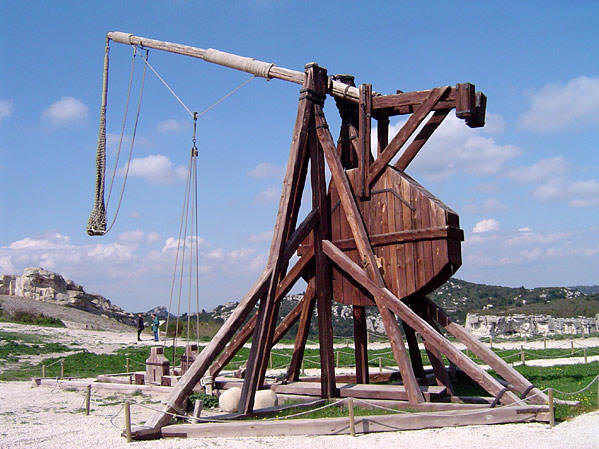 Warm-Up: Warm-Up:
1) How does a trebuchet turn human energy to potential energy to
kinetic energy?
2) When a trebuchet is firing, is it best for the counterweight to
move fast or slowly?
floating arm
http://www.youtube.com/watch?v=H8BRKtHLpQA
trebuchet
http://www.youtube.com/watch?v=CyCJ69GU974
piano and car
http://youtu.be/-wVADKznOhY
Today:
Homework:
- Complete the rest of the midterm review.
-
Brief
Essay
-- Due today, on exam day, or by the end of the quarter.
Here's the school writing
rubric.
|
 Class 38
Wednesday,
1/8 Class 38
Wednesday,
1/8
Warm-Up:
1. What do you notice about this Blob jump picture?
2. How did energy change form during the sequence shown on the
right?Today:
- Review answers to Review through part III, #20.
-
Answers to Midterm Review
- Finish Lab Tasks (last page of midterm review)
- Work time.
Homework:
blob jump record:
http://youtu.be/n8BX6v9k9CU
better video:
http://www.youtube.com/watch?v=Spq-K1J0yk8
|
Class 37 Monday,
1/6
 Warm-Up: Warm-Up:
How does a "Newton's cradle" work?
http://www.lhup.edu/~dsimanek/scenario/cradle.htm
Today:
- Grades have been updated. Some of you need to take the
car quiz.
- Review answers to part 1 of midterm review (#16).
- Complete Lab Tasks (last page of midterm review)
- Review work time.
Homework:
- Complete Midterm Review through #20 of part III.
-
Brief
Essay -- Due
Friday, 1/10/14 or on exam day.
Here's the school writing
rubric.
|
|
Class 37 Thursday,
1/2
Warm-Up:
Someone winds up a rubber band car and then
releases it.
The car accelerates, decelerates, and eventually stops.
- Describe the energy transformations (changes
in type of energy) that take
place during this process.
- At what point(s) is work done, and what is
the effect of that work?
Today:
- Return tests
- Begin
Midterm Review
-
**Self-generated,
HANDWRITTEN
notes will be allowed for use on
the midterm exam. You may create one page (one side of an 8.5"x11" sheet of paper)
of notes for use on the exam. "Self-generated" means that you
must create this sheet yourself. It may not be simply copied from another
source (e.g. another student). This is in addition to the formulas that
will already be provided.
Homework:
|
Class 36 Thursday,
12/19
 Warm-Up: Warm-Up:
1. What's the terminal velocity of a
snowflake?
http://e-collection.library.ethz.ch/eserv/eth:23207/eth-23207-02.pdf
2. How wide was the largest recorded
snowflake?
3. What is the difference between a
"snowflake" and a "snow crystal?"
4. How do you fold paper to cut a
perfect snowflake?http://ms-t-inc.com/pdf-file/snowflak.pdf
Final car standings:
[Note: a few
numbers seemed way off, so I adjusted them to more reasonable
values. If you have evidence that I sold you short, please
show me the evidence.]

|
Rank |
Group Member Names |
Maximum Velocity (m/s) |
|
1 |
Ashlyn, Sonja, Sarah |
6.1 |
|
2 |
Morgan, Jackie, Dominique |
5.23 |
|
3 |
Anna, Emily, Allie |
4.18 |
|
4 |
Hannah, Gabrielle |
4 |
|
5 |
Faris, Char, Maria |
3.86 |
|
6 |
B
n A |
3.7 |
|
7 |
Alex, Ben, Butthead |
3.66 |
|
8 |
Carolyn, Liam |
3.57 |
|
9 |
Kara, Christina |
3.33 |
|
10 |
Eniz, Peter |
3.3 |
|
11 |
Danielle and Emily |
3.19 |
|
12 |
Sarah F Mary D Shelby K |
3.05 |
|
13 |
Karyn, Natalie, Mackenzie |
2.93 |
|
14 |
Dylan, Chris, Zach |
2.82 |
|
15 |
Alex, Sarah and Sam |
2.82 |
|
16 |
Chris, Dom, Ryan |
2.81 |
|
17 |
Jake and Justin |
2.44 |
|
18 |
Zach, Pat, John |
2.44 |
|
19 |
Trevor and Adam |
2.4 |
|
20 |
Deanna, Claudia |
2.22 |
|
21 |
Tran, Ellie |
1.87 |
|
22 |
Andrew, Ryan, Tyler |
1.87 |
|
23 |
Alyssa and Sophie |
1.7 |
Today:
- Congratulations to Ashlyn Nuckols, Sonja Unica, and Sarah
Root! Their car reached 6.1m/s (13.6 mph)!
- Quiz
- Collect the necessary data to complete your car's row in
this spreadsheet:
Cardboard Car Data -- Version 2.0
Including measuring your car's force of rolling friction, using
the ramp. You can complete this data table next class.
Homework:
|
Class 35 Tuesday,
12/17
 Warm-Up: Warm-Up:
Guess how this thing is supposed to be used to fix a car's
steering? (Hint: a bolt and wing nut go in the hole.
Today:
- Check/review practice quiz.
Solutions to practice quiz.
- The group with the confirmed fastest run by the end of the
day today will be declared the winners. If any group beats
their record next class, an additional prize will be provided.
- Get a still photograph of your car.
- Collect the necessary data to complete your car's row in
this spreadsheet:
Cardboard Car Data -- Version 2.0
Including measuring your car's force of rolling friction, using
the ramp. You can complete this data table next class.
Homework:
|
|
Class 34 Friday,
12/13
Warm-Up:
The camera frame rate is 240 frames per second. If a car
crosses a floor tile in 20 frames, what is its velocity?
Today:
- Hand out practice quizzes.
- Fine-tune cars. If you want more parts, e-mail me a
file and give me cardboard.
- Collect the necessary data to complete your car's row in
this spreadsheet:
Cardboard Car Data -- Version 2.0
Including measuring your car's force of rolling friction, using
the ramp.
Homework:
- Complete practice quiz.
- Quiz next Thursday.
- Final road test next class.
|
|
Class 33 Wednesday,
12/11
Warm-Up:
How can steering be adjusted?
Today:
- Check/review problem set 3, 10-13 and problem set 4.
- Assemble and test cars. Hole reinforcers and wooden
rubber band cleats are available.
- Test cars. Assess the effect of lubrication on rolling
friction -- try ramp and velocity measurement without
lubrication before trying it with lubrication.
- Collect data and enter into this spreadsheet.
Cardboard Car Data -- Version 2.0
Homework:
- Think of ways to make your car go even faster.
|
|
Class 32 Monday,
12/9
Warm-Up:
1. What do each of the variables stand for in this
formula? PE = mgh
2. If a 0.5kg car is raised to the top of a 2m tall ramp,
how much potential energy has been stored in the car?
3. If you ignore the effects of friction, how much KE
should the car have when it reaches the bottom of the ramp?
Today:
- Check/review problem set 3, 1-9.
- Work on
car
analysis problems. Finish problem sets 1 and 2, all
questions. Check your progress by entering
answers into this spreadsheet:
Car Analysis
Spreadsheet
- Assemble cars. Hole reinforcers and wooden rubber band
cleats are available.
- Test cars Assess the effect of lubrication on rolling
friction -- try ramp and velocity measurement without
lubrication before trying it with lubrication.
- If your car is not ready today, or if you are missing some
parts, turn in the correct file and/or cardboard
Homework:
- Finish problem set 3 and complete problem set 4.You can
check your answers with the spreadsheet above. If you
start getting wrong answers, and you can't figure out why, just
keep going. Since you use previous answers to calculate
later answers, you won't get the later problems right if you got
the earlier problems wrong. That's okay. There will
be a way to find out if you did the later ones right without
doing them all over again.
|
|
Class 31 Thursday,
12/5
Warm-Up:
-
What can we do with a
bowling ball hanging on a long, thin cable?
-
How can we measure and
compare the forces of "rolling friction" that act against
various rubber band cars?
-
How can we decrease the
force of rolling friction?
Today:
- Send Mr. Stapleton your car files, and give him cardboard.
- Work on
car
analysis problems. Complete problem sets 1 and 2 by
the end of next class. Check your progress by entering
answers into this spreadsheet:
Car Analysis
Spreadsheet
Homework:
- Complete Car Analysis Problem set 3 (#1-9). You can
check your answers with the spreadsheet above. If you
start getting wrong answers, and you can't figure out why, just
keep going. Since you use previous answers to calculate
later answers, you won't get the later problems right if you got
the earlier problems wrong. That's okay. There will
be a way to find out if you did the later ones right without
doing them all over again.
|
Class 30 Tuesday,
12/3
Warm-Up:
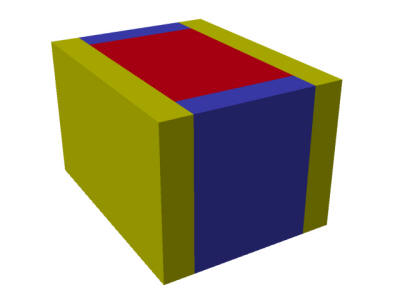
Download
this file, and then open it in Rhino. Use the parts to
build the box shown on the right. The first person to
build a box gets some fruit snacks!
(Hint: use the "move" command in the
"transform" menu. Make sure "Osnap" is turned on and "end"
is chosen. You will also need to rotate one side 90
degrees.)
Today:
- Rule changes: Maximum allowed force = 100N.
Maximum allowed bounding box volume = 800in3.
- Design Car version 2.0. Confirm that your car does not
exceed 800in3
- Create laser cutting layout for car 2.0. Upload to the
"iteration 2.0" folder in your class' cardboard car
google drive folder by the end of class.
- Find/provide cardboard for car version 2.0. Give this
to Mr. Stapleton.
Homework:
|
Class 29 Friday,
11/22
Warm-Up:
Energy input = Work = force x distance
One way to measure your car's energy in put is to multiply
average rubber band force by the rubber band's stretch distance.
Another way would be to multiply the average force of the car's
wheels pushing backward against the road by ________.
In comparison to the rubber band force, the wheel force would be
_______ (higher or lower) and its work distance would be
_________ (shorter or longer). In theory, the amount of
work (and energy) should be _________.
spreadsheet
Today:
Upcoming Deadlines:
- Each group member must e-mail Mr. Stapleton a jpeg rendering
of your new car (version 2.0) with the parts that he or she
created shown in color. The rest of the car should be
grey. Each group member must contribute changes to the
car, even if they are cosmetic.
This individual e-mail is not due
until December 5th.
- The group must upload a version car "version 2.0" laser
cutter file to the appropriate Google Drive folder
by the end of next class (December
3rd).
- The group must turn in cardboard sufficient for cutting
parts with the file uploaded to the Google Drive folder.
This is due by the end of class
on December 3rd.
Homework:
- Find and prepare cardboard.
|
Class 28 Wednesday,
11/20
Warm-Up:
What can you do to your car to make it go straighter?
Today:
Homework:
|
Class 27
Monday,
11/18
Warm-Up:
Rubber band cars need an input of energy in
order to travel. The most energy efficient
cars turn more of that energy into motion. The energy
input turns into an output of motion.
- What determines a rubber band car's energy input? In
other words, how can you increase or decrease a car's energy
input?
- By watching cars, how can you tell which cars have the
greatest energy output?
- Suppose a car has an energy efficiency of 50%. What
does that mean?
- What kinds of things affect a car's efficiency?
Today:
- Check/review homework questions.
- Test your car (Version 1.0) and determine its maximum
velocity. Enter that velocity in to the class Google
spreadsheet.
- If there's time, determine your car's energy input.
Calculate its energy output and efficiency. Enter those
values into the Google spreadsheet.
Next Class:
Finish determining your car's force, energy, efficiency, etc.
Any time:
Create a new laser cutting layout file and put it in the appropriate
folder in your Google drive. Give Mr. Stapleton the correct
size cardboard, and he will cut the parts for you before the next
class.
Homework:
|
Class 26
Thursday,
11/14
Warm-Up:
How can we measure the traction of a rubber band car?
Today:
Next Class:
Re-design cars; design Version 2.0.
Any time:
Create a new laser cutting layout file and put it in the appropriate
folder in your Google drive. Give Mr. Stapleton the correct
size cardboard, and he will cut the parts for you before the next
class.
Homework:
finish the back side of the Torque
notes/problems/questions sheet
|
|
Class 25
Tuesday,
11/12
Today:
Ideas:
- Virtual Spare parts "bins" (wheels, frames,
cross-members...). If you don't see what you're looking
for, ask.
Homework:
|
Class 24
Friday,
11/8
 Warm-Up: Warm-Up:
- By the end of next class, each
group must submit wheel cutting layout drawing
file(s). Drawing files should look like the top
diagram on the right. The wheel design should include
extra wheel locks and any other necessary components.
Maximum cardboard dimensions are 23.5" (horizontal) x 11.5"
(vertical).
-
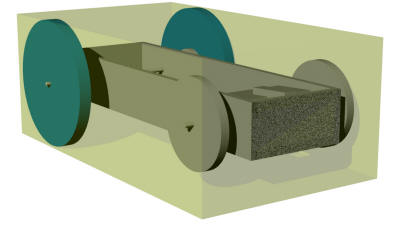 By
the end of class today, you must each submit, individually,
a rendering of the rubber band car with your wheels
attached. You must show your car in a translucent
bounding box (as shown on bottom right) and communicate the
volume of that bounding box. By
the end of class today, you must each submit, individually,
a rendering of the rubber band car with your wheels
attached. You must show your car in a translucent
bounding box (as shown on bottom right) and communicate the
volume of that bounding box.
Today:
- Finish wheel design.
- Create 3-D rendering of your car and email the rendering to
Mr. Stapleton
- Specific directions for turning in today's assignments:
-
Email
wheel renderings of your assignment to Mr. Stapleton.
Include…
-
In
the subject line, include “[your name] wheel rendering”
-
Attach your jpeg rendering
-
Include the volume of your bounding box in the email message
or subject line
-
Email your group's
wheel cutting layout file. Name the file “[group
names] v1 wheels [h x v]”.
The “h” and “v” in the file name should be the horizontal
and vertical dimensions of your cardboard, in inches.
Next Class:
- Find and cut cardboard. Turn-in cardboard to Mr.
Stapleton for creation of your wheels.
- Submit your wheel cutting layout file.
- Notes and problems relating to cars. Topics may
include torque, friction, energy, work...
Videos:
Homework:
- If you want special cardboard, find some and bring it to
next class.
- Make sure that you have turned in your car rendering and
that your group is prepared to quickly submit your wheel cutting
layout file.
|
Class 23
Wednesday,
11/6
Warm-Up:
- What is torque?
- Suppose a nut is "frozen" onto a bolt. To loosen
it, you're going to need to exert 80 foot·pounds of
torque. You are unable to do this with the wrench that
you are currently using. What kind of wrench should
you look for?
- If you put much larger diameter wheels on your
car, what will that do to your acceleration?
Today:
- Design new wheels, using Rhino
Handouts:
Videos:
Homework:
None
|
Class 22
Monday,
11/4
Warm-Up:
What is the easiest way to use a video to determine a rubber
band car's maximum velocity?
Today:
Handouts:
Videos:
Homework:
Enter your data in to the spreadsheet by next class
|
Class 21
Thursday,
10/31
Warm-Up:
No warm up today
Today:
- Return tests
- Assemble cardboard cars. Use Rhino to figure out
assembly.
Handouts:
Videos:
Homework:
Keep an eye out for more good cardboard
|
Class 20
Tuesday,
10/29
Warm-Up:
Today:
- Test
- Cardboard car demo
- Get cardboard. Laser cut and construct car bodies.
Handouts:
None
Videos:
Homework:
|
Class 19
Friday,
10/25
Warm-Up:
Suppose we create a video of a coffee
filter falling to the ground. By analyzing the video, how can
we tell if/when it has reached its terminal velocity?
Today:
- Check and review Practice Test (A5/6 gets another 10 minutes
to finish)
- Preview of car project -- check laptops for Rhino
installation. Which ones are missing Rhino? Will it
open and operate? Watch laser cutting in Fab Lab (D104)?
Handouts:
None
Videos:
Homework:
- Bring in a piece of single-ply cardboard (about 3/16") from
which a 7" x 17" rectangle can be cut. Ideally, the grain
of the cardboar should run in the long direction.
- Study for test.
|
Class 18
Wednesday,
10/23
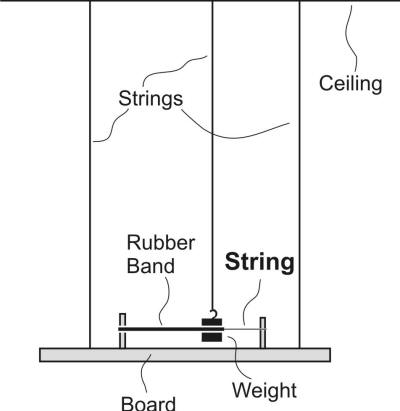 Warm-Up: Warm-Up:
1. What will we see when the
string labeled with a bold font is burned?
2. What information do you need in order to give a better
answer to question #1?
Today:
- View some videos from last class
- Rubber-Band Car Problems
- Newton's Laws Practice Test
Handouts:
Videos:
Homework:
Complete Practice Test?
|
Class 17
Monday,
10/21
Warm-Up:
Suppose you find yourself stranded in the
middle of a room because the floor is completely frictionless.
-
In this case, why wouldn't you be able
to walk to the edge of the room?
-
Describe what you could do in order to
escape.
Today:
Videos:
Homework:
|
|
|
Class 15
Thursday,
10/10
Warm-Up:
 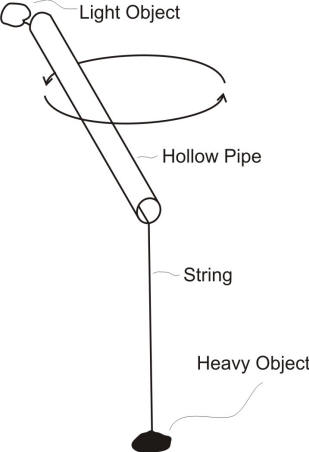 The
Earth's orbit represents a "balance." It does not fly away
from the Sun, and it does not get pulled into the sun. The
Earth's orbit represents a "balance." It does not fly away
from the Sun, and it does not get pulled into the sun.
1. What prevents the Earth from flying
away from the Sun?
2. What prevents the Earth from flying
into the Sun?
3. According to Newton's 1st Law, are the
forces that are acting on the Earth balanced?
4. When the pipe on the right is swung in
a circle, what happens to the objects and string?
5. This year, the autumnal equinox fell on
September 22. What does that mean? Today:
- Review homework.
- Final rocket launch
- Use your rocket's video to determine your rocket's time
aloft and terminal velocity.
Homework: Complete
Newton's
Laws Textbook Questions
|
|
Class 14
Tuesday, 10/8
Warm-Up:
What made some rockets successful? What
made others unsucessful? How might you make your rocket go higher
and come down slower?
Today:
Homework:
- Complete
Practice Problem
#2. Click the link to see it. It is on its own page.
- Finish
anything you didn't finish in class
|
|
Class 13
Friday, 10/4
Warm-Up:
An inch is 2.54cm. If someone is 5 feet 10 inches tall (with
shoes on), how many meters is that?
Today:
Handouts: Rocket
Analysis Spreadsheet directions
Homework: none
|
|
Class 12
Wednesday, 10/2
Warm-Up:
Read this rocket launch procedure.
Following this procedure will allow us to determine the rocket's
acceleration, terminal velocity, and force.
In the classroom...
- Record the empty (dry) mass of your rocket.
- Record the water level to which you have
filled your rocket (so that you can later determine water mass).
Outside...
- Form a line
- Remove the bottle cap before you approach
the launcher.
- Immediately before launching, have one
group member stand beside (not in front of) the launcher (to allow
scaling of the video).
- Count down loudly and pull the launch cord
gently.
- The group member who stood next to the
launcher before the launch must stand next to the fallen rocket
after it has reached the ground (again, to allow scaling of the
video).
- Clean up the launch area.
Today:
- Review homework
- Launch rockets
- Clean up
Videos:
Homework: none
|
Class 11
Monday, 9/30
Warm-Up:
1. Can you balance a meter stick on your finger
with the meter stick standing on end? 2.
If you tape a heavy weight to one end of the meter stick, will it be
easier to balance with the heavy end touching your finger or with
the light end touching your finger? 3.
Why?
Today:
Videos: Newton's
1st Law Notes
from last year
Newton's 2nd Law Notes
(also from last year)
Handouts:
Homework: Complete 1st and 2nd Law
Practice
|
Class 11
Thursday, 9/18
Warm-Up:
I am going to put a big rock on my head.
Then I am going to put a piece of wood on the rock, and someone is
going to hammer a nail into the wood. Will this hurt me?
Why or why not?
Today:
- Return tests.
- Work on rockets
Homework:
|
|
Class 10
Tuesday, 9/24 Today:
- Mr. Stapleton still in Idaho.
- Construct rockets.
- Clean up and put things back
- Store your rockets in the appropriate bag. Put usable
spare parts in the spare parts bag.
Homework:
- Gather rocket materials (if there's something else that you
need)
|
|
Class 9
Friday,
9/20 Today:
- Mr. Stapleton is gone to Idaho. Ms. Serabian is here.
- Test
- Research and design rockets
- Turn in rocket design sketch sheet.
Links:
Homework:
- Gather rocket materials (if they are not provided) and bring
them to next class.
|
Class 8
Wednesday, 9/18
 Warm-Up: Warm-Up:
It is possible to pull the paper out from under
the pen without tipping the pen. How can it be done? Why
does that work?
Today:
- Check and review practice test. Test next class
- Remind me who brought in bottles.
- Introduction to rocket design -- make paper rockets.
Videos:
Homework:
- Study for test. Review the practice test and all notes except for
Newton's laws.
|
Class
7
Tuesday, 9/16/13
Warm-Up:
There is a heavy object tied to the ceiling with a string.
There is an identical string hanging from the object. I am going to
pull on the bottom string until one of the two strings breaks.
Which string is going to break first? Why?
Today:
Videos:
Plan for the Week:
- Wednesday -- check/discuss practice test. Make paper
rockets.
- Friday -- Mr. Stapleton gone. Test. Research and
design bottle rockets.
- Tuesday -- Mr. Stapleton gone. Build bottle rockets
Related Links:
Videos:
Handouts:
Homework:
- Finish the practice test
- Test on Friday
|
|
Class
6
Thursday, 9/12/13
Warm Up:
What would happen if you made a hole
through the center of the Earth, and you jumped in? If you came
out the other side, where would you be? (antipodes
map)

Excel spreadsheet -- falling through the earth
Today:
- Return Quizzes
- Motion problems and calculating acceleration
- Work time. 1) Complete video analysis. Staple your
video analysis graph sheet to your logger pro graph sheet. 2) Complete the motion problems -- due next class.
Handouts:
"Working With Motion
Formulas"
Video: This
is a great
video explaining the entire motion formulas handout -- except for
the fact that I accidentally had the camera in low resolution mode (long
story). At least you can hear clearly.
Homework:
|
 Class
5 Tuesday, 9/10/13 Class
5 Tuesday, 9/10/13
Warm Up:
The sets of dots on the
right represent frames of video taken of two different balls that are
falling from the sky.
The video camera takes pictures at a
constant rate of 30 fps (frames per second).
One of the balls is in free-fall.
The other ball is falling at a constant
velocity.
-
Which ball is accelerating?
-
How can you tell?
-
What do you think "free fall" means, from a physics
standpoint?
Today:
- Quiz -- velocity and acceleration
- Finish spool tractors; turn-in graphs of position vs time. On
your graph, show calculations for the velocity of your fastest run.
- Use slow motion video
(and
this spreadsheet) to create higher-quality graphs of position vs
time and velocity vs time. Use your velocity vs time graph to
determine your spool tractor's maximum acceleration.
Homework: Look for
2-liter bottles! Bring them to class. Please!
|
| Class 4
Friday, 9/5/13
Warm Up:
1. A car circles a track at a constant speed of
70mph. Is its velocity constant?
2. Records of 132 cats that jumped from windows of buildings showed a
90% survival rate. The average
drop was 5.5 floors.
Injuries increased with increasing heights up to 7 floors.
When cats fell from over 7 floors, they actually suffered from
“less injuries.”
Why do injuries increase
from floors 1-6? Why would injuries decrease at over 7
floors?
Today:
- Check/review homework
- Acceleration
Notes I put a video of these notes
on youtube.
- Work on spool tractors; create graphs of position vs time.
Calculate velocities. Print a graph for your fastest run.
Homework:
- Quiz next class over velocity notes and acceleration notes.
Know the answers to all of the questions, and be able to solve
similar problems.
|
Class 3
Wednesday, 9/4/13
.JPG) Warm-Up:
The graph on the right shows the positions at different times for seven
different people. On a sheet of paper, list all of the people who
are... Warm-Up:
The graph on the right shows the positions at different times for seven
different people. On a sheet of paper, list all of the people who
are...
- moving at a constant speed
- moving backward (toward the sensor)
- not moving at all
- accelerating
- decelerating
- accelerating the fastest
- moving at the fastest constant speed
Today:
- Turn in course expectations signature if you haven't already.
- Does anyone have 2-liter bottles to turn in?
- Return papers
- Finish velocity notes
- Work on "spool tractors." Try to achieve the highest
measurable (with a motion detector) velocity.
- Next class -- calculate spool tractor accelerations
Homework:
Complete the last page of the velocity notes handout.
|
| Class 2
Friday, 8/30/13 Warm Up Question:
When you throw a "frisbee," it is often advisable
to tilt the fast side of the disc downward.
1. Which side is the fast side? 2.
Why tilt it downward?
3. Why is "frisbee" in quotation marks?
4. What's the connection to the PVC pipes
you saw last class?
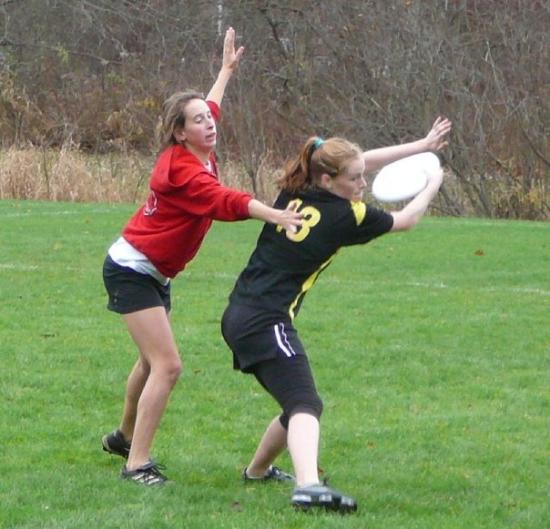
Today:
- Warm-up
- Turn in course expectations if you have had them signed
- Motion matching activity
- Velocity notes
- Clean up.
Handouts:
Video:
Homework:
- **Get course expectations sheets signed and returned by next
class. (A56 can have an extra day.)
- We will be needing bottles in the near future. Bring in 2-Liter bottles (or any other large bottles with caps
that are compatible with 2-liter bottles -- must be for carbonated
drinks). They are not due next class.
|
| Class 1 A-Day: Wednesday, 8/28.
Physics
100: Mr. Stapleton
Warm Up Question:
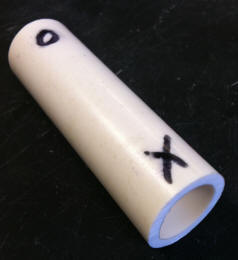 Spin
one of the "sprotating cylinders" by pressing one end until it squirts
out from under your finger. Try pressing the other end. Spin
one of the "sprotating cylinders" by pressing one end until it squirts
out from under your finger. Try pressing the other end.
When the cylinder is spinning, why do you only see the
symbol that you press?
Slow motion
Today:
- Learn names/pronunciations
- Fill out info sheets
- Enter attendance
- Slideshow(s)
- Go over course expectations, class overview
- Mr. Stapleton background, philosophy, etc.
- Itroduction to lab next class: Motion Detecting, part 1 (matching graphs)
Handouts:
Homework:
- Sign and return course expectations by next Wednesday, 9/4.
Turn in the whole sheet. If you need another copy, print one
from this website. [I forgot to tell A5/6 to do this. They can
have more time.]
|
 Warm-Up:
Warm-Up:
 Class
73
May 15, 2014
Class
73
May 15, 2014
 Class
70
May 6, 2014
Class
70
May 6, 2014 Class
66 Thursday,
4/17/14
Class
66 Thursday,
4/17/14 21.
Explain how a magnetic guitar pickup sends signals to an
amplifier.
21.
Explain how a magnetic guitar pickup sends signals to an
amplifier.


 Bats
have two very sensitive ears and the ability to produce prolonged
series of sound waves. By making a sound and then listening to
the echo, how can a bat hear a difference between...
Bats
have two very sensitive ears and the ability to produce prolonged
series of sound waves. By making a sound and then listening to
the echo, how can a bat hear a difference between... Class
50 Wednesday,
2/19/14
Class
50 Wednesday,
2/19/14 Class
49 Monday,
2/17/14
Class
49 Monday,
2/17/14 acting
on an object. In which direction will the object move?
acting
on an object. In which direction will the object move?

 Link
Link
 Warm-Up:
Warm-Up:  Class
43 Thursday,
1/30/14
Class
43 Thursday,
1/30/14 Warm-Up:
Warm-Up:  Class 38
Class 38
 Warm-Up:
Warm-Up:  Warm-Up:
Warm-Up: 
 Warm-Up:
Warm-Up: 
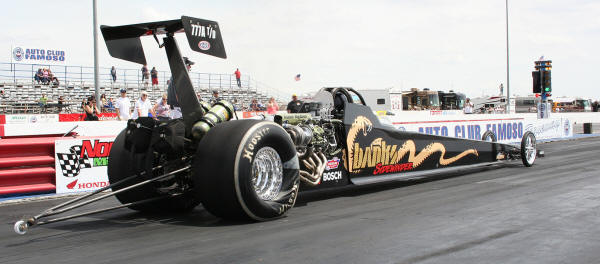
 Warm-Up:
Warm-Up:
 By
the end of class today, you must each submit, individually,
a rendering of the rubber band car with your wheels
attached. You must show your car in a translucent
bounding box (as shown on bottom right) and communicate the
volume of that bounding box.
By
the end of class today, you must each submit, individually,
a rendering of the rubber band car with your wheels
attached. You must show your car in a translucent
bounding box (as shown on bottom right) and communicate the
volume of that bounding box. Warm-Up:
Warm-Up:
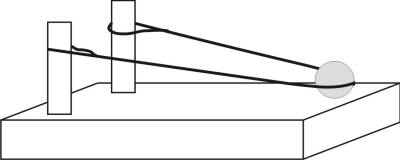

 The
Earth's orbit represents a "balance." It does not fly away
from the Sun, and it does not get pulled into the sun.
The
Earth's orbit represents a "balance." It does not fly away
from the Sun, and it does not get pulled into the sun. Warm-Up:
Warm-Up:

 Class
5 Tuesday, 9/10/13
Class
5 Tuesday, 9/10/13.JPG) Warm-Up:
The graph on the right shows the positions at different times for seven
different people. On a sheet of paper, list all of the people who
are...
Warm-Up:
The graph on the right shows the positions at different times for seven
different people. On a sheet of paper, list all of the people who
are...
 Spin
one of the "sprotating cylinders" by pressing one end until it squirts
out from under your finger. Try pressing the other end.
Spin
one of the "sprotating cylinders" by pressing one end until it squirts
out from under your finger. Try pressing the other end.